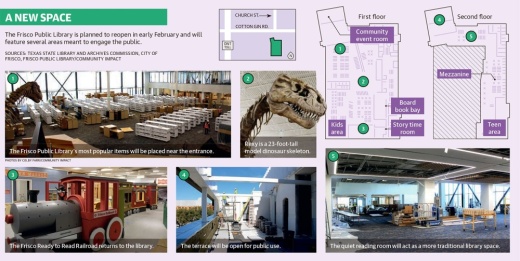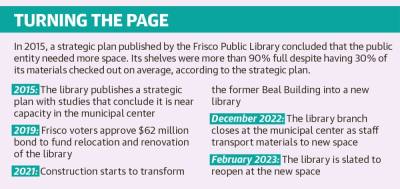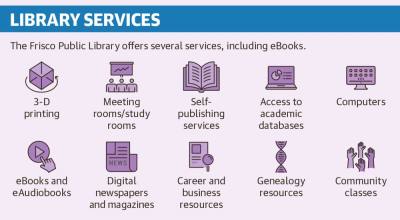When the library reopens in early February at 8000 Dallas Parkway, visitors will get their first look at the new 156,000-square-foot space, which is nearly triple the size of its previous home. The building, formerly a rocket factory owned by Beal Aerospace Technologies, sports an open-space plan that spans two floors and includes several rooms meant to engage the community.
The new library was built to accommodate a city with a population of 285,000 people and will feature indoor and outdoor special event spaces, a computer lab, a children’s area that promotes hands-on learning and more, according to a Frisco Public Library facts sheet.
“When we started planning this new library, we wanted it to be something that would serve the needs of this community upon build out,” Frisco Mayor Jeff Cheney said. “It would be that sense of community pride for all of Frisco.”
In 2019, Frisco residents voted in support of a $62 million bond to relocate the library from the municipal center after a study found the city’s library needed more space. The shelves were nearly full, and the library had circulated 1.37 million items in 2015.
“I think that we have exceeded anyone’s expectations,” Cheney said. “When ... they walk through those doors the first time, I think there’s gonna there’s gonna be a lot of wow moments from the public.”
Moving day
The library closed its branch at the George A. Purefoy Municipal Center on Dec. 9. The next day, staff members began “shelf reading” the books in the old space to make sure they were in the proper order, Material Services Handler Elizabeth Chase said.
“It’s very hard to put other books in order on the shelves if the ones that are on there aren’t in order to begin with,” she said.
A 2014 study found that the library’s shelves were more than 90% full despite 31% of the collection being checked out on average, according to the Frisco Public Library’s master plan published in 2015.
Several options were considered for expanding the library including branch libraries across Frisco, according to the master plan. Though branch libraries require less initial funding, maintaining a single space is more cost effective.
Frisco residents are still able to check out eBooks, eAudiobooks and digital magazines via the OverDrive and Libby applications while the library is moving. A limited children’s collection is also available at Connection at Stonebriar Centre.
As recently as 2021, Frisco’s physical circulation numbers reached nearly 1.9 million, more than double the circulation of the average library system in Texas, according to data from the Texas State Library and Archives Commission.
The public library’s physical collection includes books, movies and CDs, nearly a quarter of a million items in total that have to be moved over, Chase said. Frisco residents had checked out nearly 50% of the library’s existing collection before it closed though, she said.
In addition to the existing collection, the new library will open with nearly 24,000 new books, Chase said.
The library has about 4.5 miles of shelves when lined up, Frisco Public Library Director Shelley Holley said. Chase said she was excited to have more space for the collection, something the library did not have in its previous location.
“I’m really excited for the collection to have breathing room,” she said. “The shelves won’t be 90% full anymore. They’ll be about half full. ... We want to have room to grow as the community continues to grow.”
Library priorities
The new public library was designed and constructed with five priorities in mind: lighting, power, data, sightlines and acoustics, Holley said.
“We had the great good fortune of visiting a lot of libraries over five years up to planning this one,” she said. “We came back here and realized there are five things we have to get right for this building to really work.”
With their library card, residents will be able to reserve one of more than 20 meeting rooms that will be available, Holley said. Residents can reserve a room online and will receive a code via email that will unlock the reserved room at the appointed time.
The library’s meeting room options include two 20-person conference rooms, three 12-person conference rooms and several four-person, six-person and eight-person conference rooms, Holley said. A community event room at the north end of the building can hold 300 people.
There is one meeting room, called the “unconference room,” that features no technology and holds more casual furniture like a coffee table.
Donna Schmittler, president of the Friends of the Frisco Public Library, said she was excited to see new opportunities open up for local clubs and organizations to meet at the new library. As Frisco’s population grows and becomes more diverse, it becomes harder for groups to find available spaces for meetings or activities.
“I think when people walk in there and see the size and scope [of] the building itself, and all that’s available, I think they’ll be really impressed,” Schmittler said.
Friends of the Frisco Public Library is a nonprofit organization that accepts donated books that are gently used.The nonprofit was expected to begin moving its bookstore to the library’s new space in January. They will have a publicly accessible space for their own workroom and bookstore, which will operate like a department store at a mall. All proceeds from book sales are donated to the library.
Lighting the library posed a particular challenge, Holley said. The lighting had to be bright enough without creating glares or hotspots. Most of the library’s lighting reaches a color rendering index of about 70, which is good, Holley said. CRI is used to measure how accurately colors are portrayed by a lighting source in comparison to natural light. In the quiet reading room on the second floor, the CRI measurement reaches about 90, which is exceptional, she said.
In addition, each shelf on the first floor will have its own lighting.
Rexy, a 23-foot-tall T-Rex model skeleton, acts as a gateway to the children’s area on the first floor, Holley said.
An interactive “Tiny Town,” found along the south side of the first floor, features Leadership Frisco’s Ready to Read Railroad train and some interactive learning areas for children, including a grocery store, a construction site and a veterinary clinic.
As a grandparent, Schmittler said she was excited to see the activities and programs that will be available for children, including the expanded Ready to Read Railroad train.
“I think the outreach for children has always been very good,” Schmittler said. “But there’s going to be so much more in this space.”
Design influences
The architecture firm Gensler designed the new library to highlight Frisco’s connection to the Blackland Prairie, the primary ecological region found throughout North Texas.
“Even when they were making the library itself, it was supposed to give you the idea of being out in Blackland Prairie,” she said.
Reminiscent of dogtrot-style homes that were common on the Blackland Prairie in the 19th and early 20th century, two entrances on the library’s north and west side create an interior breezeway, according to Gensler’s website. The landscaping outside will feature about 33 native plants and trees.
“[The project] really kind of came from a vision of being the essential heartbeat for Frisco,” Cheney said.
When people talk about the future of libraries, there is so much more that happens at a library than people are aware of, Cheney said. The new library was designed so people can have different experiences on different days.
“What’s being created there is going to be a place that people just want to be at,” he said









